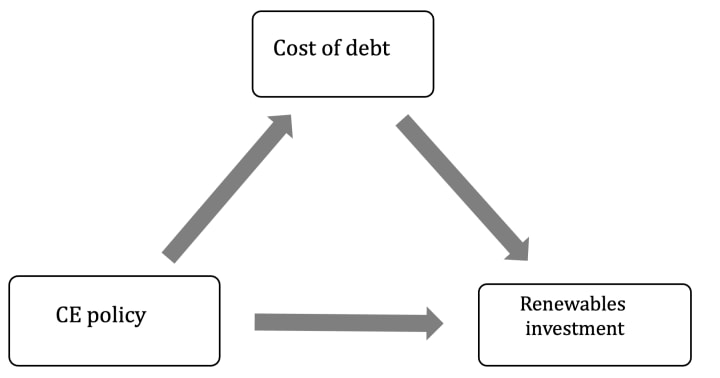This is how climate and environmental policies influence energy investment choices
climate and environmental policies

Governments play a crucial role in shaping the energy sector's transformation through the implementation of climate and environmental (CE) policies. These policies not only aim to drive change but also have a profound impact on the perceptions and behaviors of market participants. Environmental economists have long advocated for the use of policy instruments, such as carbon taxes or cap-and-trade systems, to effectively price carbon emissions. By doing so, these policies seek to internalize the environmental damages caused by carbon dioxide emissions and provide economic incentives for transitioning to cleaner energy sources.
The effectiveness of CE policies can be primarily attributed to their ability to stimulate innovation and enhance the capacity of renewable energy technologies. It is widely believed that these policies, either directly or indirectly, increase investments in renewable energy projects by reducing the cost of capital. The cost of capital holds significant influence in the real economy as it affects capital flows and investment decisions.
To illustrate this, let's consider an example. Suppose the cost of debt for financing renewable energy projects increases dramatically from 1.5% to 7.5%. In such a scenario, the costs associated with the United Kingdom's ambitious net-zero transition by 2050 would soar by 30%. This example highlights the critical role played by the cost of capital in determining the feasibility and pace of the net-zero carbon transition. If the energy transition risk is factored into the cost of capital, it becomes imperative to examine how this influences the overall shift towards a carbon-neutral future.
Despite the recognition of the importance of CE policies in influencing the cost of capital and investors' risk preferences, there remains a lack of comprehensive empirical studies in this domain. Therefore, there is a need for further research to substantiate and deepen our understanding of how CE policies specifically impact the cost of capital and shape investors' attitudes towards risk. By gaining more empirical insights, policymakers can refine their strategies, ensuring that CE policies are designed and implemented in a manner that maximizes their positive impact on the energy sector's transformation.
What does the research show?
The Energy Transition Risk and Cost of Capital (ETRC) Project is a comprehensive initiative that goes beyond simply tracking the cost of capital for energy firms. We delve into quantitative analysis to explore the various factors that influence the cost of capital and examine how it shapes investment decisions, with a specific focus on distinguishing between low-carbon (green) and high-carbon (brown) investments. Our recent paper within the ETRC project tackles a compelling question: how does regulation risk impact investment choices, both directly and indirectly by influencing the cost of capital?
To address this question, we employ longitudinal datasets from the syndicated loan market. Our analysis encompasses a sample of 15,189 loan facilities extracted from the LPC DealScan database, spanning the period between 2000 and 2019. These loans involve 4,066 borrowers across 40 developed and emerging markets in the energy production sector (including renewable energy, oil & gas, and coal) as well as the electricity sector (encompassing both renewables and fossil fuel-based sources).
Employing rigorous econometric techniques that account for project-, firm-, and macro-level factors, we scrutinize the impact of climate and environmental (CE) policies, proxied by the stringency of OECD environmental policies, on loan spreads and investment decisions. Our findings shed light on the following key observations:
1. In the energy production sector, we discover that stronger CE policies tend to reduce the cost of capital for green (renewable energy) production while simultaneously increasing it for brown (oil & gas and coal) production. To provide a tangible example, an increase of one standard deviation in the strength of CE policy leads to a decrease of thirty-one basis points (or 0.31 percentage points) in the cost of debt for renewable energy production, as compared to a loan issued for conventional energy sources. Intriguingly, however, we do not observe a similar impact of CE policies on investment choices between green and brown electric utilities.
2. CE policies exert a direct influence on investment decisions, regardless of whether they pertain to the energy production sector or the electric utility sector. Stronger CE policies act as a catalyst for increased investment in renewable energy production, surpassing investments in oil & gas or coal. Likewise, more robust CE policies foster greater investment in renewable electric utilities, compared to those reliant on fossil fuels.
Through the ETRC project's meticulous analysis of loan data and econometric modeling, we offer valuable insights into the intricate relationship between CE policies, the cost of capital, and investment preferences. Our research highlights the pivotal role that regulatory risks play in shaping the energy sector's transformation and underscores the importance of effective policy frameworks to encourage the transition toward cleaner and more sustainable energy sources.
What are the implications for policy-makers?
Our research provides compelling evidence that climate and environmental (CE) policies have a dual effect: they not only reduce the cost of capital for green investments compared to their brown counterparts but also stimulate increased investments in green alternatives. These findings raise two fundamental questions that warrant exploration:

1, What is the precise impact of the cost of capital on investment decisions?
2. Considering that CE policies influence investments through both direct and indirect channels, what are the relative strengths of these two pathways?
To address the first question, our analysis reveals a clear relationship between the cost of capital and investment choices. Specifically, we find that a decrease in the cost of capital translates into a noticeable increase in investments directed towards renewable energy projects. This observation aligns with the underlying premise discussed earlier and comes as no surprise, as a more affordable cost of capital naturally encourages greater investment in renewable technologies.
Turning to the second question, our research uncovers intriguing insights. While both the direct and indirect channels exhibit influence on investment decisions, we discover that the direct channel exerts a significantly stronger impact, approximately 14 times greater, compared to the indirect channel. This finding, highlighting the substantial influence of the direct channel, may seem surprising at first glance. However, it can be attributed to CE policies often focusing on accelerating the deployment of renewable technologies, which tend to be costlier, through mechanisms such as feed-in tariffs. These mechanisms reduce the financial burden for renewable energy projects, thus directly stimulating investments.
Furthermore, we hypothesize that as renewable technologies become increasingly cost-competitive, the indirect channel may gain more prominence in shaping investment decisions. As the costs of renewable technologies continue to decline and their efficiency improves, they naturally become more attractive from a financial standpoint. Consequently, the indirect influence of CE policies, through reducing the cost of capital, is expected to grow in significance as the financial viability of renewable projects strengthens. These hypotheses provide a direction for future research, as further investigation is necessary to gain a deeper understanding of the dynamics between CE policies, the cost of capital, and investment preferences.
Key takeaways
The analysis presented in this study offers valuable insights from a policy perspective, highlighting the effectiveness of stronger climate and environmental (CE) policies in driving increased investments in green alternatives compared to their brown counterparts. Notably, our findings emphasize that these policies primarily exert a direct influence on investment decisions rather than solely relying on the indirect pathway of reducing the cost of capital. This suggests that financial institutions, as rational actors, take into account the risks associated with CE policies when making investment choices. As a result, it becomes clear that policymakers seeking to expedite the low-carbon transition should consider deploying robust policy instruments to effectively guide capital flows towards low-carbon energy initiatives.
It is important to note that this article forms part of a broader research endeavor conducted in collaboration with the Cost of Capital Observatory. The Observatory is an esteemed initiative jointly led by the International Energy Agency, the World Economic Forum, ETH Zurich, and Imperial College London. Its overarching objective is to enhance transparency within the energy sector and inspire investor confidence, with a particular emphasis on emerging and developing countries where data on financing costs is often limited. By providing a freely accessible resource that offers comprehensive data on the cost of capital, with a specific focus on clean energy projects in emerging and developing economies, the Observatory seeks to fill crucial information gaps and empower investors in making informed decisions.
Through the collaborative efforts of the Cost of Capital Observatory, policymakers, investors, and other stakeholders gain access to a robust repository of data, enabling them to better understand the financing landscape in the clean energy sector. By shedding light on the costs associated with capital investments in emerging and developing economies, the Observatory contributes to the overall objective of facilitating sustainable and inclusive energy transitions worldwide. This initiative serves as a valuable tool for policymakers, aiding in the design and implementation of effective strategies that promote the growth of clean energy projects and attract investment in regions that require additional support.
In conclusion, the research presented here reinforces the importance of strong CE policies in driving green investments while highlighting the direct influence of these policies on investment decisions. Moreover, it underscores the significance of initiatives like the Cost of Capital Observatory in increasing transparency and fostering investor confidence, particularly in emerging and developing economies. By leveraging the insights gained from such research collaborations, policymakers can shape effective policy frameworks that steer capital flows towards low-carbon energy and advance the global transition to a more sustainable future.
About the Creator
nizam uddin
My name is Nizam Uddin and I am thrilled to be a part of Vocal.com's community of writers. As a passionate technology enthusiast, I am excited to share my insights and opinions on the latest trends and innovations in the world of tech.






Comments
There are no comments for this story
Be the first to respond and start the conversation.